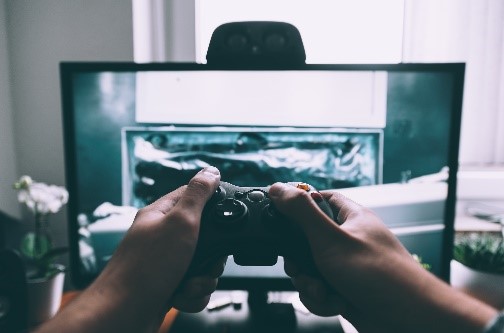Get Up. Stand Up. Stand Up for Your Health
The typical 9 to 5 office job involves a lot of sitting. Sure, everyone’s heard of standing or walking desks, but most people don’t have them.
 Even if you want to get up and walk around, or stretch throughout the day, sometimes your work schedule doesn’t allow it or sometimes you forget. But how bad is sitting all day for you really? It may not necessarily be “the new smoking” as some have claimed, but it’s also not the best for your health, at least short-term. The risks and consequences of sitting are, for the most part, fairly immediate and directly related to your musculoskeletal health [1].
Even if you want to get up and walk around, or stretch throughout the day, sometimes your work schedule doesn’t allow it or sometimes you forget. But how bad is sitting all day for you really? It may not necessarily be “the new smoking” as some have claimed, but it’s also not the best for your health, at least short-term. The risks and consequences of sitting are, for the most part, fairly immediate and directly related to your musculoskeletal health [1].
The Problem with Sitting
Sitting can be a major pain in the neck – and a pain in many other parts of the body. Sitting for more than 95% of your day at work has been found to be a risk factor in developing neck pain and it can also be a significant factor in fatigue and lower back discomfort [2]. When you attempt to reduce sitting time in the office, it can have a major impact on musculoskeletal discomfort. In fact, a reduction in musculoskeletal pain in the neck and shoulders was found after a concentrated campaign to reduce sitting time among office workers [3].
Musculoskeletal pain is common – 63% of office workers report experiencing it, with the most common locations being the neck, upper back and lower back [4]. The prevalence of low back pain in occupations that require workers to sit for the majority of the working day is significantly higher than the prevalence in the general population [5]. It’s not just sitting too much at work that can contribute to low back pain. When focusing on an individual’s total sitting time – both sitting at work and sitting during leisure time (e.g. when watching TV), it was found that there is a strong relationship between total sitting time and low back pain intensity [6]. This includes other types of workers including manual labourers, who may not sit a lot during their jobs but may sit a lot during their leisure time. It was found that sitting during leisure time actually has more of a detrimental effect on low back pain than workplace sitting.
What Can You Do About It?
 Get moving! It has been found that transitioning from sitting to standing every 30 minutes can significantly reduce fatigue levels and low back pain [7,8].
Get moving! It has been found that transitioning from sitting to standing every 30 minutes can significantly reduce fatigue levels and low back pain [7,8].
Adjustments to the height or positioning of your chair, computer monitor or other elements of your workstation have also been found to decrease work related musculoskeletal pain [9]. Introducing short bouts of physical activity throughout the day has also shown to improve the overall wellbeing of office workers [2].
Massage Therapy Can Help
 If you’re already experiencing musculoskeletal pain associated with sitting too much, massage therapy can help. Regular on-site massage in an office environment has been found to be an effective treatment for decreasing the duration of musculoskeletal ache, pain or discomfort, and for increasing range of motion [10]. Massage therapy can also have an immediate positive effect on neck and shoulder pain [11], and can also be an effective treatment for chronic low back pain [12]. In a recent study, individuals with back pain who received massage therapy had less pain and were better able to perform daily activities than those who only received usual medical care, without massage [13].
If you’re already experiencing musculoskeletal pain associated with sitting too much, massage therapy can help. Regular on-site massage in an office environment has been found to be an effective treatment for decreasing the duration of musculoskeletal ache, pain or discomfort, and for increasing range of motion [10]. Massage therapy can also have an immediate positive effect on neck and shoulder pain [11], and can also be an effective treatment for chronic low back pain [12]. In a recent study, individuals with back pain who received massage therapy had less pain and were better able to perform daily activities than those who only received usual medical care, without massage [13].
A Registered Massage Therapist can offer suggestions for exercises and other forms of self-care that will help you to take an active role in your health care and will be beneficial for reducing your musculoskeletal pain. Registered Massage Therapists can also provide suggestions for modified working ergonomics to help reduce discomfort and strain.
References
[1] Van Uffelen, J.G., Wong, J., Chau, J.Y., van der Ploeg, H.P., Riphagen, I., et al. (2010). Occupational sitting and health risks: a systematic review. Am J Prev Med, 39(4):379-388. [link]
[2] Ariënsa, G.A., Bongersa, P.M., Douwesa, M., Miedemaa, M.C., Hoogendoorna, W.E., et al. (2001). Are neck flexion, neck rotation, and sitting at work risk factors for neck pain? Results of a prospective cohort study. Occup Environ Med, 58(3):200-207. [link]
[3] Bergouignan, A., Legget, K.T., De Jong, N., Kealey, E., Mikolovski, J., et al. (2016). Effect of frequent interruptions of prolonged sitting on self-perceived levels of energy, mood, food cravings and cognitive function. Int J Behav Nutr Phys Act, 13:113. [link]
[4] Janwantanakul, P., Pensri, P., Jiamjarasrangsri, V., Sinsongsook, T. (2008). Prevalence of self-reported musculoskeletal symptoms among office workers. Occup Med (Lond), 58(6):436-438. [link]
[5] Lis, A.M., Black, K.M., Korn, H., Nordin, M. (2007). Association between sitting and occupational LBP. Eur Spine J, 16(2):283–298. [link]
[6] Gupta, N., Christiansen C.S., Hallman, D.M., Korshøj, M., Carneiro, I.G., Holtermann, A. (2015). Is Objectively Measured Sitting Time Associated with Low Back Pain? A Cross-Sectional Investigation in the NOMAD study. PLoS One, 10(3):e0121159. [link]
[7] Thorp, A.A., Kingwell, B.A., Owen, N., Dunstan, D.W. (2014). Breaking up workplace sitting time with intermittent standing bouts improves fatigue and musculoskeletal discomfort in overweight/obese office workers. Occup Environ Med, 71(11):765-71. [link]
[8] Danguah, I.H., Kloster, S., Holtermann, A., Aadahl, M., Tolstrup, J.S. (2017). Effects on musculoskeletal pain from “Take a Stand!” – a cluster-randomized controlled trial reducing sitting time among office workers. Scand J Work Environ Health, 43(4):350-357. [link]
[9] Van Vledder, N., Louw, Q. (2015). The effect of a workstation chair and computer screen height adjustment on neck and upper back musculoskeletal pain and sitting comfort in office workers. South African J Physiotherapy, 71(1). [link]
[10] Siško, P.K., Videmšek, M., Karpljuk, D. (2011). The effect of a corporate chair massage program on musculoskeletal discomfort and joint range of motion in office workers. J Altern Complement Med, 17(7):617-622. [link]
[11] Kong, L.J., Zhan, H.S., Cheng, Y.W., Yuan, W.A., Chen, B., Fang, M. (2013). Massage therapy for neck and shoulder pain: a systematic review and meta-analysis. Evid Based Complement Alternat Med, 2013:613279. [link]
[12] Cherkin, D.C., Sherman, K.J., Kahn, J., Wellman, R., Cook, A.J., et al. (2011). A comparison of the effects of 2 types of massage and usual care on chronic low back pain: a randomized, controlled trial. Ann Intern Med, 155(1):1-9. [link]
[13] Eaves, E.R., Sherman, K.J., Ritenbaugh, C., Hsu, C., Nichter, M., et al. (2015). A qualitative study of changes in expectations over time among patients with chronic low back pain seeking four CAM therapies. BMC Complement Altern Med, 15:12. [link]


Leave a Comment